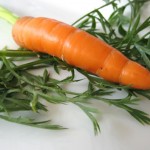 We have heard that it is healthy to eat your vegetables raw? I bet many of us have heard that one time or another. Many experts push raw vegetables as being anti-cancer along with aiding to long life. The reasoning is that raw vegetables lose their vitamins and enzymes during the cooking process. What if I told you I found facts that are different from what the experts say?!
We have heard that it is healthy to eat your vegetables raw? I bet many of us have heard that one time or another. Many experts push raw vegetables as being anti-cancer along with aiding to long life. The reasoning is that raw vegetables lose their vitamins and enzymes during the cooking process. What if I told you I found facts that are different from what the experts say?!
Raw Vegetables
It is all the rage in some parts of the country to eat raw vegetables, and many vegetarians and vegans will stand by that idea too. Let’s look at the facts. When you eat raw vegetables, while you do gain high amounts of nutrients, the calorie count is low. When all is said and done we can only absorb about 50 calories per pound of raw vegetables. There is a reason we find cattle out in the fields eating grass all day.
To try and exist on just a completely raw vegetable diet would be hard overtime. You would have to consume large amounts of fruits, avocado, nuts and seeds. While you might lose a lot of weight (not always a good thing), you may also gain skin issues, thin hair, and muscular wasting. I have often observed these symptoms in many of my clients that have been on this type of diet for an extended amount of time.
Am I saying raw vegetables are a waste of time to eat? No, we have to find balance and understand that, yes, some vegetables are great raw such as; lettuce, spinach, carrots, tomatoes, cucumbers, and onions to name a few. A good rule of thumb I use is, “if it would work in a salad, then eat it raw.” But there are some very good reasons to cook some of your vegetables!
Cooked Vegetables
The raw food camp will state that about 50% of the nutrients in food are destroyed by cooking, along with most of the enzymes. Yes, high temperature cooking, especially frying or barbecuing will destroy vast amounts nutrients and create toxic compounds. I would tend to say these types of cooking are more extreme and might be relabeled as OVERCOOKING! Where does just cooking vegetables on the stove top fall?
Steaming vegetables helps to break down cellulose and make the tough cellular walls of vegetables cells much easier for the body to digest. Just boiling your vegetables in the pot does wash away the water soluble vitamins such as vitamin C. If you don’t have a vegetable steamer or steaming basket that works with your cookware it could be well worth your health to pick one up.
Another method of cooking raw vegetables to gain nutrients would be making a soup. Yes a small about of nutrients will be lost, but this makes many more nutrients absorbable, which would have been lost if these vegetables had been eaten. The heating, softening and moisturizing of vegetables and beans dramatically increases digestibility of many beneficial nutritious compounds.
Here is a neat fact! Cooking can destroy some of the harmful anti-nutrients that interfere with the bodies ability to absorb nutrients. You will get more nutrients than if you just ate the vegetables raw. If you are eating a soup, any of the nutrients that did wash into the liquid in cooking will be eaten when you consume the vegetables and the liquid of the soup.
Another plus of cooking vegetables is that studies have shown the body absorbs more of the anti-cancer compounds such as carotenoids and phytochemicals when vegetables are cooked when compared to raw. Very neat, since most people prefer cooked vegetables over raw.
Fermented Vegetables
Want to have your cake and eat it too, then fermented foods maybe for you. Most lacto-fermented foods are made from raw vegetables, without heat. These raw vegetables are allowed to culture over a few days in an anaerobic enviroment with a salt-water brine, during which the lacto-bacilli grow and culture the food. This type of food preparation is nothing new and has been done since the time of the building of the Great Wall of China. Some of the first original lacto-fermented foods were sauerkraut and pickles.
Lacto-fermented foods have the great benefits of both raw and cooked vegetables. During the lacto-fermenting process the tough cellular walls of vegetables are broken down, allowing for a much easier level of absorption by the body. A plus is that during the lacto-fermentation process the vitamin levels actually increase along with enzyme levels, often by 2 to 3 times.
One last plus that lacto-fermented foods have over raw or cooked vegetables is their pro-biotic count. During the lacto-fermenting process the levels of beneficial pro-biotics can climb to easily pass the numbers of any pro-biotic supplement. These great lacto-bacilli help to build the flora (good bacteria) in the digestive tract, which in turn builds and supports the immune system. Our ancestors knew this fact and often consumed lacto-fermented foods daily to help maintain their health.
There is only one catch when dealing with lacto-fermented foods. You will have to make them yourself. Since they are alive they keep maturing until you eat them. If they were in the stores they would cause jars to leak or break on the shelves since there is no way around this other than by pasteurizing the foods, which would destroy the pro-biotic count of the food along with most of the enzymes and many of the vitamins. Yes, there are some foods labeled as fermented that are sold in stores, but as you see this is marketing and not true.
Making Lacto-fermented Foods
It is really easy to make these types of foods once you understand the how. We offer a Lacto-fermenting eCourse that takes you through what you need to know to prepare many different types of lacto-fermented foods. Our cookbook, Lacto-fermenting The Easy & Healthy Way, gives you just about all of the recipes you will ever need. The lacto-fermenting kits provide the special hardware you need to produce these great foods.
Many Choices – Winner?
There are many choices and methods of how to prepare vegetables and each works good for its type. Lettuce and greens are best raw since they stimulate the start of digestion. Harder stemmed vegetables such as broccoli work best steamed. Many different types vegetables work in lacto-fermenting, making a food that is super high in nutrition and digestibility. As far as a winner on which is best to eat I would choose all three!
What do you think?




Speak Your Mind